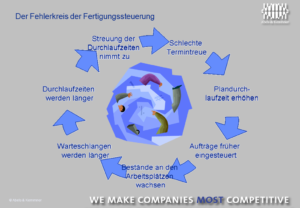From range-oriented scheduling to push and pull systems
Götz-Andreas Kemmner
In our guide to inventory optimization, the author provides valuable suggestions based on knowledge gained from many projects, which can be used to avoid overstocking. Were at the center of Part 1 of the series in F+H 6/2008 In this second and concluding part, you will learn interesting facts about range-oriented scheduling and how to recognize surpluses and stock drivers. In order to emphasize the urgency of the issue of inventory reduction, the form of direct address was chosen in this article.
 Do you also like to discuss cost-optimized order quantities in your company? There is no end to the number of dissertations and theses on this subject. It is such a beautiful, systematic game with formulas and influencing variables and yet so beautifully systematically wrong. Firstly, you cannot correctly determine all significant cost influences anyway. Secondly, there are other constraints that limit you in your choice of batch size regardless of the cost optimum. Thirdly, the costs change by less than five percent between half and double the optimum batch size for many items. These are lost in the measurement inaccuracy of the calculation and cost recording. Therefore:
Do you also like to discuss cost-optimized order quantities in your company? There is no end to the number of dissertations and theses on this subject. It is such a beautiful, systematic game with formulas and influencing variables and yet so beautifully systematically wrong. Firstly, you cannot correctly determine all significant cost influences anyway. Secondly, there are other constraints that limit you in your choice of batch size regardless of the cost optimum. Thirdly, the costs change by less than five percent between half and double the optimum batch size for many items. These are lost in the measurement inaccuracy of the calculation and cost recording. Therefore:
Tip no. 6: Schedule according to reach
Instead, look at the expected future requirements at the end of the replacement period and summarize them for a reasonable period of time. A period of one to two weeks may be the right length of time for items in large quantities and in regular demand, but in some sectors it may be a matter of hours. However, it can sometimes be six months for low-cost items that are rarely in demand. If the expected demand increases, you automatically order more with this procedure, if the demand decreases, you order less. As a result, your order quantity is adapted to your actual requirements.
If you are currently planning articles with reorder points and fixed lot sizes, you can generally manage their stock in this way. significantly.
Tip no. 7: Qualify your dispatchers
Many companies treat their employees like the U. S. Navy treated its pilots at the beginning of the 20th century after it received its first airplanes. The pilots were asked to teach themselves how to fly. However, the Navy quickly abandoned this idea, as the material costs – surprisingly there were hardly any personal injuries – were considerable. When weighing up the costs, the U. S. Navy quickly opted for the lower training costs instead of the higher material costs. Does this sound familiar to you? In many companies, dispatchers still have to teach themselves how to “fly” or are trained by their colleagues.
Try a training strategy. You will see that the stocks will decrease a little again. In our projects, in which we provide theoretical and practical training for dispatchers, stocks are also melting away in product areas that we have not yet dealt with.
Tip no. 8: Straighten out your planning processes
Now you have already gone a long way along the optimization path. However, there are still some large overstock rocks ahead of you. To clear these out of the way, you need increasingly in-depth knowledge and possibly also heavier equipment and, as a rule, external support. An example will illustrate this.
Imagine you are in Berlin and want to go to Milan. If you get on the right plane, you have already made a large part of the journey. It may be difficult to find your way from the airport to Milan Cathedral, but at least you’ll be close by. It would be more difficult if you were to ask yourself after landing why everyone is suddenly speaking Swedish. If you cannot simply determine your material requirements on an order-related basis because the customer is patient enough, you are faced with exactly the same problem, but in a more serious way.
If you move in the wrong direction at the beginning of the planning process, when forecasting requirements, the precision of the subsequent planning steps will be of no use at all. A reliable forecasting process is therefore an essential prerequisite for avoiding the majority of excess stocks in the future and giving existing excess stocks a chance to reduce more or less quickly, so to speak.
Again, I don’t want to advise you against listening to the forecasts of your ERP system from time to time, if it is able to create demand forecasts at all. But consider the following facts:
- Virtually all forecasting methods available in our standard ERP systems are statistically incorrect.
- A demand planning process is not particularly good if the forecast matches the later reality as closely as possible, as is usually assumed, but if the required delivery readiness is achieved with the lowest possible average stock at the end of the demand planning process.
A supposedly good forecast in conjunction with incorrectly determined safety stocks and, depending on the scheduling method used, can lead to inadequate delivery readiness and excessive stocks. An external expert can help you to check whether your ERP system’s forecasts are good enough or whether you should use an external system, which is the subject of the next recommendation.
Tip no. 9: Organize first, then optimize
External forecast optimization systems are often necessary and helpful. Although many companies use appropriate software solutions, it is surprising at first glance that they have not been able to reduce their inventories. This is because these systems are not operated and maintained correctly. So it is not enough to buy a great system with as many functions as possible; it is also not enough if there is also a lot of training. Rather, you need to align your entire planning processes with the use of the forecasting system and you need someone who can competently monitor and regularly maintain the basic settings of the entire system.
If you take this tip to heart, your investment will not rust out, but will help you to significantly reduce your stocks.
Tip no. 10: Check the planning and control principle
On the other hand, there is the pull principle, which works like last week’s shopping trip to the supermarket: empty shelves are replenished again and again by the previous stage of the value chain. The pull principle has become popular here, particularly in its Japanese Kanban system form.
At the moment, push systems are considered uncool and in many companies, they are used for all they’re worth. Everyone wants to be involved and everyone does Kanban, even if the possibilities and knowledge are only sufficient for a small Kanban system between the central warehouse and the assembly line.
Experience shows that pull systems, provided that the logistical and production conditions allow their use, manage with significantly lower circulating stocks than push systems. Theoretically, push systems should be able to work more precisely and with less inventory than pull systems. Generally speaking, however, production is a process that cannot be planned in detail. Push systems react much more sensitively to these planning uncertainties than pull systems, which results in higher circulating stocks in practice.
However, it would be fundamentally wrong to conclude from this that pull systems are always the right solution, as some advocates of Japanese production organization like to do, because if you look closely, there are very few pure push or pure pull systems.
If you produce in series in whole or in part, the products or materials flow fairly evenly and the development department is not constantly coming up with technical changes, then you may want to switch to pull control in these areas. If you implement the principle properly and size it correctly, your circulating stocks in these areas could well shrink by more than 30 percent.
Tip no. 11: Position your production correctly
Do you still occasionally make coffee conventionally, using the coffee funnel on the coffee pot and adding water by hand? This used to be called “brewing coffee”. Haven’t you ever had a coffee overflow? The coffee slowly flows out of the bottom of the funnel, which is kept as full as possible up to the rim – although we all know that hardly any more flows out of the bottom just because we fill the coffee funnel up to the rim. And before we know it, the coffee is dripping out of the pot, but the funnel is still half full.
If orders are coming in because the workload is high, we also tend to brew coffee in production. We place as many orders as possible in production, which in a figurative sense consists of a whole series of coffee brewing funnels and, like the coffee at home, the stocks in production are overflowing. The only way to get the circulating stocks down is to use sensible ‘brewing behavior’: If you pour fewer production orders into production at the front, the stocks can flow out again at the various hoppers in production, the circulating stocks fall and you reduce some stocks again.

I know you already had this wise insight. So why is production so full? If you keep up your “brewing behavior” for longer – and there are said to be companies where this has already happened – all status messages in the PPS system will slowly but surely turn red. No one knows what needs to be produced first, work in progress is constantly increasing and yet output from assembly is constantly decreasing. This behavior is referred to as the production control error loop (Fig.). There is only one solution to break this vicious circle, unless you can or want to increase production capacity, and that is to put fewer orders into production. Anyone who berates you for this approach has not understood the context. Even if orders awaiting production are “burning brightly”, it is no use pouring them into production when the production hopper is already full, to stay with the image of brewing coffee. There would only be more production orders on fire. In this situation, it is better for a customer order to burn up before production than to ignite a wildfire during production.
The amount of circulating stock required for production can be determined using operating curves, although this would go too far in this article. As field surgery measures, you can firstly try to place orders with approximately the same work content in production and secondly carefully reduce the inflow of orders into production until you have the feeling that the order backlog at the bottleneck capacities is becoming too low. This will not only noticeably reduce work in progress in production, but will also help production and assembly to reduce throughput times and better meet completion deadlines.
After studying the practical advice given in Part I and Part II, you now know the route you need to take to reduce your stocks. Once you have worked your way through to tip no. 11, most of your surplus stock will have disappeared, except of course for those that can only be scrapped. Good luck!

